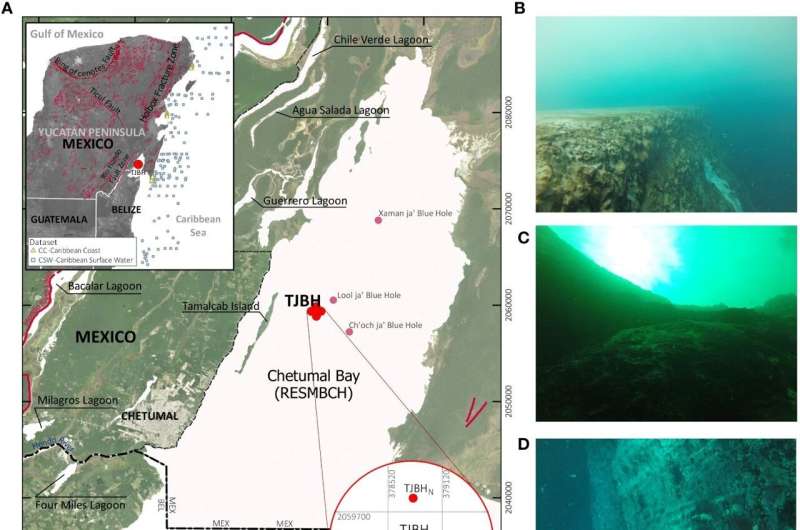Location of the Taam Ja’ Blue Hole (TJBH) in Chetumal Bay, Mexico, is presented alongside the CC and CSW data regions for further comparison of water temperature and salinity conditions. Regional fracture zones and geological faults in the Yucatán Peninsula are indicated, along with the locations of documented blue holes within Chetumal Bay. CB data was measured at sampling stations positioned at cardinal positions ~500 m apart of the TJBH (TJBHN, TJBHS, TJBHE and TJBHW). Images from scuba explorations of the TJBH at depths (B) 5.0 mbsl, (C) 20 mbsl, and (D) 30 mbsl are also presented. Credit: Frontiers in Marine Science (2024). DOI: 10.3389/fmars.2024.1387235
A small team of oceanographers from several institutions in Mexico has found evidence that the Taam Ja' Blue Hole in Mexico's Chetumal Bay, on the eastern side of the Yucatán Peninsula, is the deepest in the world. In their study published in the journal Frontiers in Marine Science, the group made a dive deep into the hole along with a conductivity, temperature and depth profiler.
Blue holes are water-filled caverns that form below the seafloor. They are most often found in coastal areas where the bedrock is prone to erosion. They develop as ocean water seeps through cracks, dissolving minerals as they go, leading to sinkholes. Over time, they can grow quite large.
Several blue holes have been found around the globe, such as the Great Blue Hole near Belize and the Dahab Blue Hole off the coast of Egypt. Up until now, the deepest known to exist was the Dragon Hole in the South China Sea, which has been measured to 301 meters.
The Taam Ja' Blue Hole was first discovered in 2021, and at the time, was believed to be approximately 275 meters deep. This past December, the researchers with this new effort conducted a more intensive study of the hole by taking a conductivity, temperature and depth profiler with them on a dive—the tool is a collection of sensors bound together in a frame and tied to a cable that is lowered into the water and directed by divers.
That dive showed the Taam Ja' Blue Hole is at least 420 meters deep, making it the deepest in the world. But it is actually deeper than that; the profiler they used was only capable of functioning at depths of 500 meters. The cable drifted, so the researchers had to subtract 80 meters. Because of that, the true depth of the hole is still unknown.
The dive team also found that the water in the hole had layers of differing temperature and salinity. One such layer found at 400 meters down had the salinity and temperature close to those of the nearby Caribbean Sea, suggesting an under-the-seabed connection between the two.
More information: Juan Carlos Alcérreca-Huerta et al, Recent records of thermohaline profiles and water depth in the Taam ja' Blue Hole (Chetumal Bay, Mexico), Frontiers in Marine Science (2024). DOI: 10.3389/fmars.2024.1387235
Journal information: Frontiers in Marine Science
© 2024 Science X Network
























